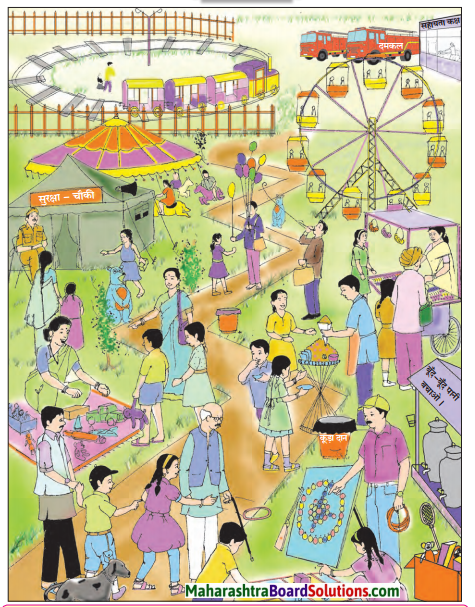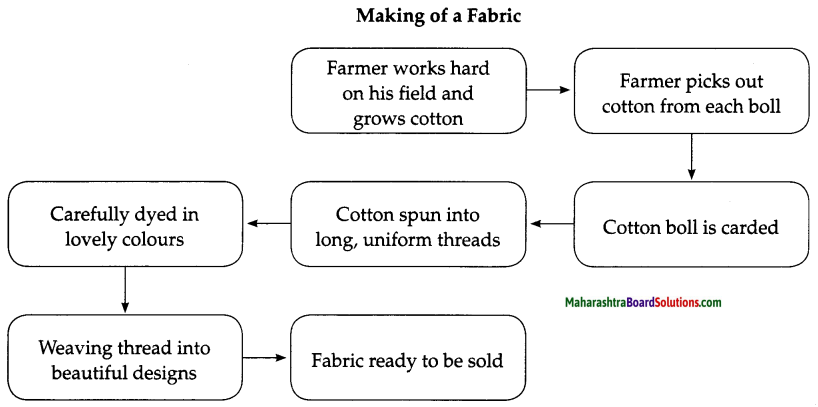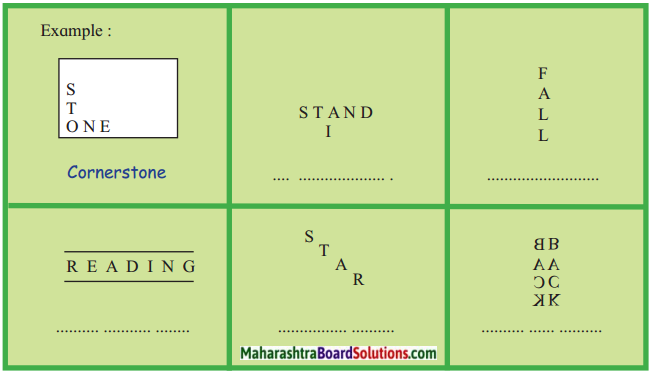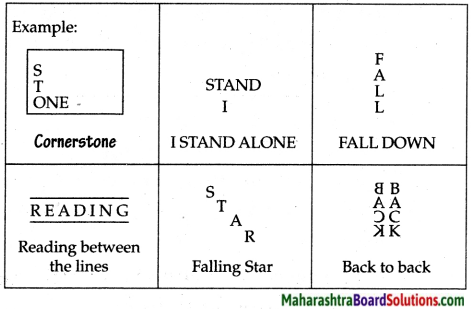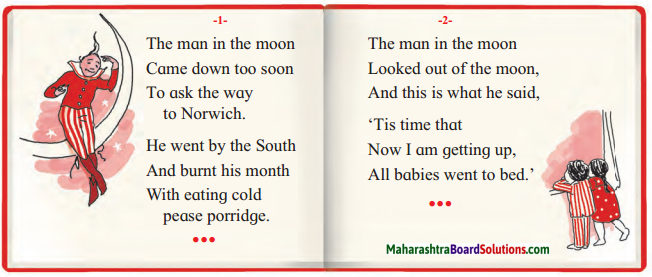Balbharti Maharashtra State Board Class 6 Hindi Solutions Sulabhbharati Chapter 1 सैर Notes, Textbook Exercise Important Questions and Answers.
Maharashtra State Board Class 6 Hindi Solutions Chapter 1 सैर
Hindi Sulabhbharti Class 6 Solutions Chapter 1 सैर Textbook Questions and Answers

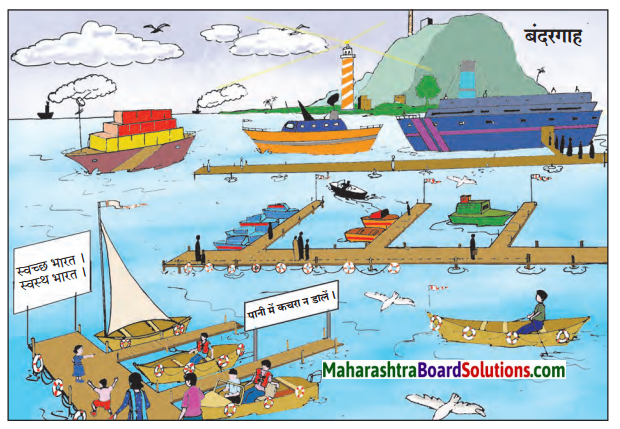

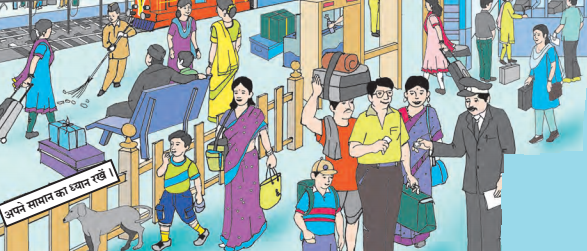
![]()
चित्रों का परिचयः
पहला चित्र बस स्थानक का है। बस स्थानक के सामने यात्रियों की यात्रा सुखद होने की कामना की गई है। बस स्थानक पर तीन विभाग दिखाई दे रहे हैं। विभाग क्रमांक १ के पास पीने के पानी की व्यवस्था की गई है। कुछ लोग बस पकड़ने के लिए बस की ओर जा रहे हैं तो कुछ लोग अपनी यात्रा पूरी कर बाहर जा रहे हैं। एक व्यक्ति समाचार पत्र बेच रहा है। बस स्थानक के बाईं ओर स्वच्छतागृह बना हुआ है। बस स्थानक पर स्वच्छता है। हमें सार्वजनिक स्थानों पर स्वच्छता रखनी चाहिए। राष्ट्रीय संपत्ति हमारी संपत्ति है। इसकी सुरक्षा करनी चाहिए।
दूसरे चित्र में बंदरगाह दिखाई दे रहा है। समुद्र के रास्ते जो सामग्रियाँ आती हैं, वे बंदरगाह पर उतारी जाती हैं। वहाँ से वे देश के अन्य हिस्सों में भेजी जाती हैं। इसी तरह विदेशों में भी इसी जगह से वस्तुओं को भेजा जाता है। बंदरगाह और जल को स्वच्छ रखने की सूचना दिखाई पड़ रही है। हमें जल को स्वच्छ रखना चाहिए। स्वच्छ भारत रखेंगे तो ही भारत स्वस्थ होगा।
तिसरे चित्र में आवागमन के साधन दिखाई दे रहे हैं। चित्र में अंतरराष्ट्रीय हवाई अड्डा दिखाई दे रहा है। हवाई अड्डे पर कार, बस, ट्रक आदि खड़े हैं।
चौथा चित्र रेल स्थानक का है। कुछ लोग स्थानक से बाहर निकल रहे हैं। एक व्यक्ति सफाई कर रहा है। हमें सार्वजनिक स्थानों | पर स्वच्छता रखनी चाहिए।
![]()
Hindi Sulabhbharti Class 6 Solutions Chapter 1 सैर Additional Important Questions and Answers
उपर दिए गए चित्रों को देखकर निम्नलिखित प्रश्नों के उत्तर लिखिए:
Question 1.
बस स्थानक पर कितनी बस दिखाई दे रही हैं?
Answer:
तीन।
Question 2.
बस पर क्या लिखा हुआ है?
Answer:
राष्ट्रीय संपत्ति, हमारी संपत्ति।
Question 3.
बंदरगाह पर पानी के वाहन कितने दिखाई दे रहे हैं?
Answer:
चौदह।
Question 4.
‘पानी में कचरा न डालें।’ कहा लिखा हुआ है?
Answer:
बंदरगाह पर।
Question 5.
स्वस्थ भारत के लिए क्या आवश्यक है?
Answer:
स्वच्छता।
![]()
सही शब्द चुनकर रिक्त स्थानों की पूर्ति कीजिए:
(यात्रा, लाल, बस स्थानक, तीन, बंदरगाह)
Question 1.
पहला चित्र ……………… का है।
Answer:
बसस्थानक
Question 2.
दूसरे चित्र में ……………… दिखाई दे रहा है।
Answer:
बंदरगाह
Question 3.
बस स्थानक पर ……………… विभाग क्रमांक हैं।
Answer:
तीन
Question 4.
आपकी ………………सुखद हो।
Answer:
यात्रा
Question 5. सरकारी बस ……………… रंग की होती हैं।
Answer:
लाल
![]()
निम्नलिखित वाक्यों के सामने सही (✓) अथवा गलत (✗) का निशान लगाइए:
Question 1.
बस स्थानक पर पुस्तकालय दिखाई दे रहा है।
Answer:
✗
Question 2.
बस स्थानक पर कूडेदान रखा है।
Answer:
✗
Question 3.
बंदरगाह के पास पक्षी उड़ रहे हैं।
Answer:
✓
Question 4.
बंदरगाह के पास पीने का पानी दिखाई दे रहा है।
Answer:
✓
![]()
निम्नलिखित प्रश्नों के उत्तर लिखिए:
Question 1.
यातायात के साधनों के नाम लिखिए।
Answer:
कार, बस, रेलगाड़ी, हवाई जहाज़ आदि।
Question 2.
यातायात के साधनों को कितने वर्गों में बाँटा जा सकता
Answer:
यातायात के साधनों को तीन वर्गों में बाँटा जा सकता है।
Question 3.
आवागमन के साधनों के तीनों वर्गों के नाम लिखिए।
Answer:
जल, थल और वायु मार्ग।
Question 4.
थल मार्ग के द्वारा यात्रा के कौन – कौन से साधन हैं?
Answer:
साइकिल, मोटर साइकिल, रिक्शा, कार, बस, रेलगाड़ी आदि।
Question 5.
यातायात के किस मार्ग के लिए बंदरगाह बनाए जाते
Answer:
बंदरगाह का उपयोग जलमार्ग के लिए किया जाता है।
![]()
दिए गए चित्र को देखकर निम्नलिखित प्रश्नों के उत्तर लिखिए:
Question 1.
हवाई अड्डे पर कितने हवाई जहाज़ दिखाई दे रहे हैं?
Answer:
तीन।
Question 2.
हवाई अड्डे पर क्या सूचना लिखी ह?
उत्तरः
धूमपान मना है।
Question 3.
चौथे चित्र में रेलगाड़ी की संख्या कितनी है?
Answer:
एक।
Question 4.
टिकट घर के ऊपर क्या सूचना लिखी है?
Answer:
लावारिस वस्तुओं को हाथ न लगाएँ।
Question 5.
रेल स्थानक पर सामान ढोने वाले को क्या कहते हैं?
Answer:
कुली।
![]()
निम्नलिखित शब्दों में से उचित शब्द चुनकर रिक्त स्थानों की पूर्ति कीजिए:
Question 1.
_______ वस्तओं को हाथ न लगाएँ।
Answer:
लावारिस
Question 2.
अपने ________ का ध्यान रखें।
Answer:
सामान
Question 3.
________ मना है।
Answer:
धूम्रपान
Question 4.
यात्रा में ________ और _________ सहायता करनी चाहिए।
Answer:
महिलाओं, वृद्धों
Question 5.
सुंदरता और स्वच्छता से राष्ट्र का नाम ________ होता है।
Answer:
ऊँचा
![]()
निम्नलिखित प्रश्नों के उत्तर लिखिए:
Question 1.
आवागमन के साधनों का क्या महत्त्व है?
Answer:
आवागमन के साधनों से समय की बचत होती है।
Question 2.
आवागमन के साधनों में सबसे तेज़ी से कौन चलता है?
Answer:
हवाई जहाज़ आवागमन का सबसे तेज़ साधन है।
Question 3.
रेल द्वारा क्या-क्या कार्य किया जाता है?
Answer:
रेल द्वारा यात्रा करने और माल ढुलाई का कार्य किया जाता है।
Question 4.
लावारिस सामान को हाथ लगाने से क्या होता है?
Answer:
लावारिस सामान विस्फोटक हुआ तो जान जा सकती है।
![]()
Question 5.
धूम्रपान क्यों नहीं करना चाहिए?
Answer:
धूम्रपान स्वास्थ्य के लिए खतरनाक होता है, इसलिए धूम्रपान नहीं करना चाहिए।

